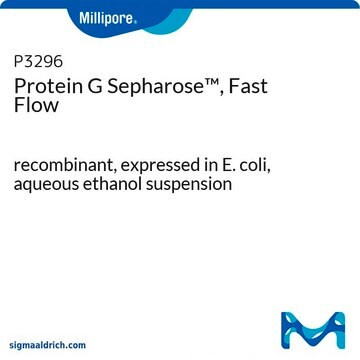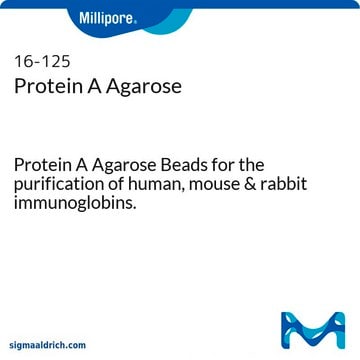P9424
ProteinA-Sepharose™ 4, Fast Flow from Staphylococcus aureus
aqueous ethanol suspension
Synonym(s):
Protein A–Agarose
Sign Into View Organizational & Contract Pricing
All Photos(1)
About This Item
Recommended Products
biological source
Staphylococcus aureus
Quality Level
form
aqueous ethanol suspension
analyte chemical class(es)
proteins (Immunoglobulins of various mammalian species)
extent of labeling
~6 mg per mL
technique(s)
affinity chromatography: suitable
matrix
Sepharose 4B Fast Flow
matrix activation
cyanogen bromide
matrix attachment
amino
matrix spacer
1 atom
capacity
≥30 mg/mL binding capacity (human IgG)
storage temp.
2-8°C
Looking for similar products? Visit Product Comparison Guide
General description
Protein A-Sepharose™ has been used to develop strategies for investigating protein interactions, to improve the detection of celiac disease, and to study diabetes in children.
Application
Protein A-Sepharose is used for affinity chromatography, antibody purification and characterization, immunoaffinity matrices, protein chromatography, protein A, G and L resins, and recombinant protein expression and analysis. Protein A-Sepharose™ has been used to develop strategies for investigating protein interactions, to improve the detection of celiac disease, and to study diabetes in children.
Protein A-Sepharose™ Fast Flow from Staphylococcus aureus has been used:
- in co-immunoprecipitation assay
- in immunodepletion
- to purify IgG from human serum and plasma
Physical form
Suspension in 20% ethanol
Legal Information
Sepharose is a trademark of Cytiva
Signal Word
Warning
Hazard Statements
Precautionary Statements
Hazard Classifications
Flam. Liq. 3
WGK
WGK 3
Choose from one of the most recent versions:
Already Own This Product?
Find documentation for the products that you have recently purchased in the Document Library.
Customers Also Viewed
János Roszik et al.
European journal of immunology, 41(5), 1288-1297 (2011-04-07)
T-cell receptors (TCRs) can be genetically modified to improve gene-engineered T-cell responses, a strategy considered critical for the success of clinical TCR gene therapy to treat cancers. TCR:ζ, which is a heterodimer of TCRα and β chains each coupled to
C Macaulay et al.
The Journal of biological chemistry, 270(1), 254-262 (1995-01-06)
During each cell cycle, the nucleus of higher eukaryotes undergoes a dramatic assembly and disassembly. These events can be faithfully reproduced in vitro using cell-free extracts derived from Xenopus eggs. Such extracts contain three major N-acetylglucosaminylated proteins, p200, p97, and
Joyce A Benjamins et al.
Neurology(R) neuroimmunology & neuroinflammation, 6(3), e550-e550 (2019-05-03)
To identify whether factors toxic to oligodendrocytes (OLs), released by B cells from patients with MS, are found in extracellular microvesicles enriched in exosomes. Conditioned medium (Sup) was obtained from cultures of blood B cells of patients with MS and
Yuhua Zhang et al.
Plant physiology, 149(4), 1860-1871 (2009-02-06)
Trehalose-6-phosphate (T6P) is a proposed signaling molecule in plants, yet how it signals was not clear. Here, we provide evidence that T6P functions as an inhibitor of SNF1-related protein kinase1 (SnRK1; AKIN10/AKIN11) of the SNF1-related group of protein kinases. T6P
Mazhar Adli et al.
Nature protocols, 6(10), 1656-1668 (2011-10-01)
Chromatin immunoprecipitation (ChIP) combined with high-throughput sequencing (ChIP-seq) has become the gold standard for whole-genome mapping of protein-DNA interactions. However, conventional ChIP protocols necessitate the use of large numbers of cells, and library preparation steps associated with current high-throughput sequencing
Our team of scientists has experience in all areas of research including Life Science, Material Science, Chemical Synthesis, Chromatography, Analytical and many others.
Contact Technical Service












